
Saitobaru Kofun Cluster is a group of three hundred thirty three kofuns or tumuli in Saito city, Miyazaki Prefecture, Japan. This is one of the largest kofun groups in Japan, and the largest group in Kyushu situated on a 70-meter hill composed of diluvium. It is located within the Saitobaru-Sugiyasukyō Prefectural Natural Park.

The Matsuoka Kofun Cluster is a group kofun burial mounds located in what is now part of the town of Eiheiji, Fukui in the Hokuriku region of Japan. The site was designated a National Historic Site of Japan in 1977 in the case of the Tegurigajoyama Kofun, the largest of the group. Protection was extended to the remainder of the group in July 2005.

The Nakagō Kofun Cluster is a group of kofun burial mounds located in the Sakashita neighborhood of the city of Tsuruga, Fukui in the Hokuriku region of Japan. The site was designated a National Historic Site of Japan in 1988.
Ōzuka-Senbōyama Sites (王塚・千坊山遺跡群) is a group of seven archaeological sites located in what is now part of the city of Toyama in the Hokuriku region of Japan. The sites consist of the ruins of a settlement which existed from the late Jōmon period through Kofun period, and several necropolis with numerous kofun burial mounds. The Ōzuka Kofun received protection as a National Historic Site in 1948 and the area under protection was expanded to cover the other six sites in 2005.

Mikuriyama Kofun group is group of kofun burial mounds located inbetween the Shingai and Kamata neighborhoods of the city of Iwata, Shizuoka in the Tōkai region of Japan. The site was designated a National Historic Site of Japan in 2001.

Shidami Kofun group is a cluster of seven Kofun period burial mounds, located in what is now part of Moriyama-ku, Nagoya, Aichi Prefecture in the Tōkai region of Japan. The Shiratorizuka Kofun was designated a National Historic Site of Japan in 1972 and the remaining six were added to the designation in 2014..
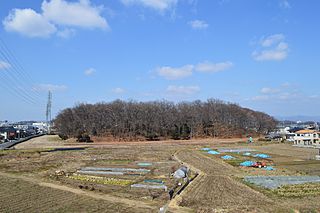
Ōta Tenjinyama Kofun (太田天神山古墳) is a Kofun period burial mound located in the Uchigashimacho neighborhood of the city of Ōta, Gunma Prefecture in the northern Kantō region of Japan. It was designated a National Historic Site of Japan in 1941. It is the largest kofun in Gunma Prefecture and the 28th largest in the country. It is the only kofun with a length in excess of 200 meters in eastern Japan.. It is also sometimes referred to as the Dantaiyama Kofun (男体山古墳).
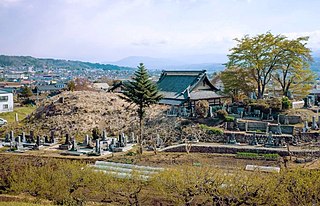
The Iida Kofun cluster is group kofun burial mounds located in the Shimoida neighborhood of the city of Iida, Nagano in the Chūbu region of Japan. Thirteen tumuli have been collectively protected as a National Historic Site since 2016.

Ryūgakuji kofun cluster is a group of Kofun period burial mounds located in what is now the Ryukakuji neighborhood of the town of Sakae and extending into the city of Narita, Chiba Prefecture in the Kantō region of Japan. The site was designated a National Historic Site of Japan in 1941, with the area extended in 2009. Containing 114 tumuli, it is the largest cluster of kofun in the Kantō region. The National Historic Site designation also singles out Kofun No. 105, which is named the Iwaya kofun (岩屋古墳).

The Naruto Itano Kofun cluster is a group of nine kofun burial mounds located between the city of Naruto and Itano, Tokushima Prefecture, on the island of Shikoku, Japan. The tumuli were collectively designated a National Historic Site in 2016.

Tsukuriyama Kofun (造山古墳) is a cluster of Kofun period burial mounds located in the Shinjōshita neighborhood of Kita-ku, Okayama, Okayama Prefecture, in the San'yō region of Japan. The cluster was designated a National Historic Site of Japan in 1921. The main Tsukuriyama Kofun is the largest burial mound in Okayama Prefecture and the fourth largest in Japan.

The Kamienyatsukiyama Kofun (上塩冶築山古墳) is a Kofun period burial mound, located in the Kamienya-cho, neighborhood of the city of Izumo, Shimane in the San'in region of Japan. The tumulus was designated a National Historic Site of Japan in 1924, with the area under protection expanded in 2020. It is one of the burial mounds that make up the Tsukiyama Kofun Cluster. The artifacts excavated from this site were collectively designated a National National Important Cultural Property in 2018.
Tsuruki Kofun Cluster (綴喜古墳群) is a Kofun cluster located in the Ōsumi-Hachiōji neighborhood of the city of Kyōtanabe, Kyoto in the Kansai region of Japan.
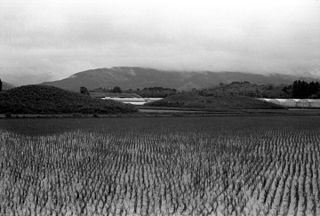
Kawaminami Kofun Cluster (川南古墳群) is a group Kofun period burial mounds, located in the Nishibeppu neighborhood of the town of Kawaminami, Miyazaki on the island of Kyushu Japan. The tumulus cluster was collectively designated a National Historic Site of Japan in 1961.

The Mochida Kofun cluster (持田古墳群) is a group of Kofun period burial mounds located in the Mochida-cho neighborhood of the town of Takanabe, Miyazaki Prefecture in Kyushu Japan. The tumulus group was designated a National Historic Site of Japan in 1961.
The Minamikata Kofun cluster (南方古墳群) is a group of Kofun period burial mounds located in the Amori-cho, Yoshino-cho, Onuki-cho, Maino-cho, Noji-cho neighborhoods of the city of Nobeoka, Miyazaki Prefecture in Kyushu Japan. The tumulus group was collectively designated a National Historic Site of Japan in 1943.
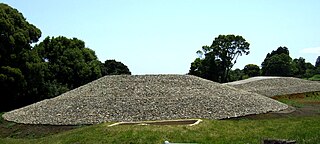
The Ikime Kofun cluster (生目古墳群) is a group of Kofun period burial mounds located in the Atoe-cho neighborhood of the city of Miyazaki, Miyazaki Prefecture in Kyushu Japan. The tumulus group was designated a National Historic Site of Japan in 1943 with the area under protection expanded in 2007.

The Honjō Kofun Cluster (本庄古墳群) is a group of Kofun period burial mounds located in the Honjō neighborhood of the town of Kunitomi, Miyazaki Prefecture in Kyushu Japan. The tumulus group was designated a National Historic Site of Japan in 1934.

Matsumotozuka Kofun (松本塚古墳) is a Kofun period keyhole-shaped burial mound, located in the Sannō neighborhood of the city of Saito, Miyazaki in Kyushu, Japan. The tumulus was designated a National Historic Site of Japan in 1944. It is also called the Funazuka Kofun (船塚古墳) as it appears to be shaped like a ship.
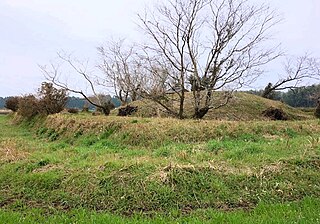
The Jōshinzuka Kofun (常心塚古墳) is a Kofun period burial mound located in the Kamisanzai-chō neighborhood of the city of Saito, Miyazaki Prefecture in Kyushu Japan. The tumulus was designated a National Historic Site of Japan in 1980.



















